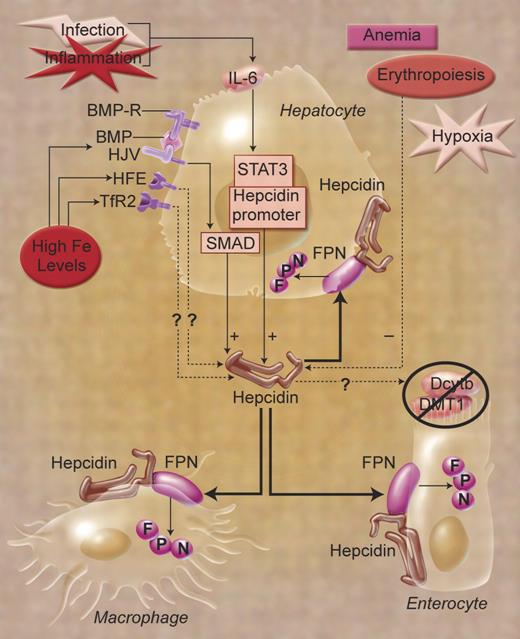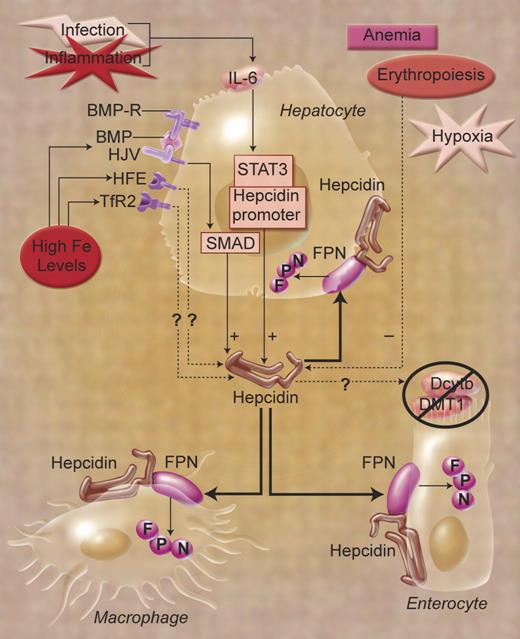In this issue of Blood, Lin and colleagues report that in freshly isolated murine hepatocytes, holotransferrin can stimulate hepcidin production and that holotransferrin regulates hepcidin mRNA levels through a hemojuvelin-BMP2/4–dependent pathway.
Iron is indispensable for life, but unless appropriately protected, it plays a key role in the formation of toxic oxygen radicals that can attack all biological molecules. Hence, mammals evolved various regulatory mechanisms that, under normal conditions, maintain iron at appropriate levels both in their cells and in the whole organism. Physiologically, all plasma iron (∼ 3 mg in humans) is bound to transferrin, which transports iron within the body between sites of utilization, storage, and absorption. The turnover of plasma iron is approximately 30 mg per day and, normally, approximately 80% of this iron is transported to the bone marrow where erythroid cells use the metal for the synthesis of hemoglobin. At the end of an erythrocyte's life, it is phagocytosed by macrophages of the reticuloendothelial system. Within the macrophage, heme is catabolized via heme oxygenase 1, which liberates the metal from its confinement within the protoporphyrin ring. Iron is then released from macrophages into the circulation with a rate that matches the rate with which erythroid cells take up iron from transferrin. Iron is exported from the cells via ferroportin, with the ferroxidase activity of ceruloplasmin facilitating the movement of iron across the membrane of macrophages. About 1 mg of dietary iron is absorbed per day, and the total iron balance is maintained by a daily loss of 1 mg via nonspecific mechanisms. Ferroportin, in conjunction with the ceruloplasmin homolog hephaestin, is involved in the exit of iron from enterocytes into the circulation.1
Recent research has identified hepcidin, the peptide hormone synthesized in the liver, as the principal regulator of organismal iron homeostasis. Although hepcidin synthesis is affected by hypoxia, erythropoietic activity, and inflammatory cytokines,2,3 the principal regulator of hepcidin production is most likely iron. It is now well established that iron administration to healthy humans or mice induces the synthesis of hepcidin, which, in turn, inhibits the release of iron from duodenal epithelial cells as well as macrophages involved in the recycling of hemoglobin iron. However, thus far, in vitro studies using either hepatoma cell lines or primary hepatocytes have failed to demonstrate increased synthesis of hepcidin in response to iron loading.3
Central role of hepcidin in organismal iron homeostasis. Cell-associated, GPI-linked hemojuvelin (HJV) is proposed to act as a coreceptor for bone morphogenetic protein (BMP) ligands and BMP receptors (BMP-Rs). Interaction of HJV with BMP ligands and 2 BMP-Rs on the cell surface generates an active signaling complex. This complex subsequently activates the intracellular SMAD signaling pathway to induce hepcidin expression. Hepcidin, a peptide secreted by the liver, promotes internalization and degradation of the iron exporter ferroportin (FPN). The pathway by which HFE and transferrin receptor 2 (TfR2) control the expression of hepcidin is unclear. Importantly, mutations in HJV, HFE, or TfR2 lead to inappropriately low levels of hepcidin. Dcytb indicates duodenal cytochrome b; DMT1, divalent metal transporter 1. This figure is a modified version of that published in Dunn et al,2 copyright Elsevier; adapted with permission by Alice Y. Chen.
Central role of hepcidin in organismal iron homeostasis. Cell-associated, GPI-linked hemojuvelin (HJV) is proposed to act as a coreceptor for bone morphogenetic protein (BMP) ligands and BMP receptors (BMP-Rs). Interaction of HJV with BMP ligands and 2 BMP-Rs on the cell surface generates an active signaling complex. This complex subsequently activates the intracellular SMAD signaling pathway to induce hepcidin expression. Hepcidin, a peptide secreted by the liver, promotes internalization and degradation of the iron exporter ferroportin (FPN). The pathway by which HFE and transferrin receptor 2 (TfR2) control the expression of hepcidin is unclear. Importantly, mutations in HJV, HFE, or TfR2 lead to inappropriately low levels of hepcidin. Dcytb indicates duodenal cytochrome b; DMT1, divalent metal transporter 1. This figure is a modified version of that published in Dunn et al,2 copyright Elsevier; adapted with permission by Alice Y. Chen.
Lin and colleagues have provided evidence that the inability of hepatocytes to synthesize hepcidin in response to diferric transferrin was due to the fact that previous studies used primary hepatocytes cultured for 48 hours before treatment with holotransferrin. In contrast, this report has clearly demonstrated that diferric transferrin, but not apotransferrin, causes an increase in hepcidin mRNA levels in freshly isolated murine primary hepatocytes.
However, it should be noted that the increase in hepcidin mRNA levels following the addition of holotransferrin to freshly isolated hepatocytes is relatively minor.
Hemojuvelin mutations result in juvenile hemochromatosis, which is indistinguishable from that caused by hepcidin mutations; furthermore, hemojuvelin has been shown to participate in the complex regulation of hepcidin. The authors therefore examined whether iron affects hepcidin production via a hemojuvelin-dependent pathway. Hemojuvelin exists both as a soluble and a cell-associated GPI-linked form, the latter being a BMP coreceptor that enhances hepcidin signaling in liver cells. As shown in the figure, BMP induction of hepcidin is enhanced via hemojuvelin in hepatocytes through a BMP/SMAD-dependent pathway. Its role as an enhancer may act to finely tune the BMP-mediated induction of hepcidin expression. Lin and colleagues have succeeded in identifying a component missing from previous in vitro studies: namely, the role of iron in the BMP/hemojuvelin/SMAD-mediated induction of hepcidin synthesis.
Conflict-of-interest disclosure: The authors declare no competing financial interests. ■
REFERENCES
National Institutes of Health



